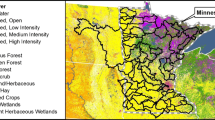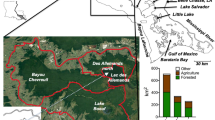Abstract
Cultural eutrophication of lakes caused by excess phosphorus (P) loading from agricultural areas is a persistent and serious environmental problem. We quantified P flows in a watershed-lake ecosystem using a simple mathematical model that coupled in-lake and upland processes to assess and compare the long-term impacts of various management strategies. Our model compares abatement by in-lake strategies (such as increasing the flux of P from algae to consumers and alum application) with riparian management to decrease P flow and with balancing P budgets at the watershed scale. All of these strategies are effective to some extent. However, only reducing the amount of fertilizer P imported to the watershed will decrease the total P in the system at steady state. Soil P—a large reservoir with slow turnover rate—governs long-term flux to the lake and must be decreased in size to maintain long-term control of eutrophication.
Similar content being viewed by others
Author information
Authors and Affiliations
Additional information
Received 2 August 1999; accepted 12 April 2000.
Rights and permissions
About this article
Cite this article
Reed-Andersen, T., Carpenter, S. & Lathrop, R. Phosphorus Flow in a Watershed-Lake Ecosystem. Ecosystems 3, 561–573 (2000). https://doi.org/10.1007/s100210000049
Published:
Issue Date:
DOI: https://doi.org/10.1007/s100210000049




